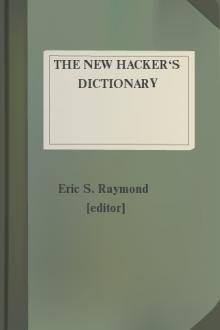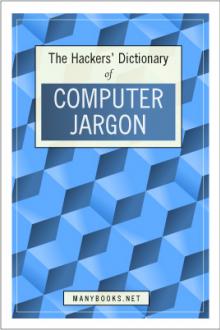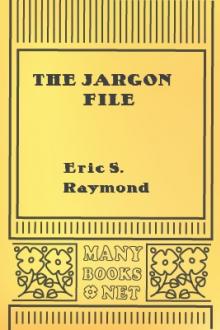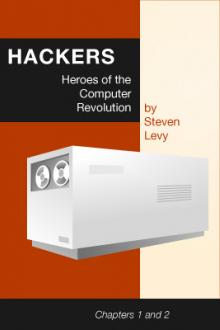The New Hacker's Dictionary by Eric S. Raymond (romantic novels to read .txt) 📕

- Author: Eric S. Raymond
- Performer: 0262680920
Book online «The New Hacker's Dictionary by Eric S. Raymond (romantic novels to read .txt) 📕». Author Eric S. Raymond
their escapades, if declassified, would probably rank among the
greatest hacks of all times. The term has been adopted in commercial
computer-security circles in this more specific sense.
Node:time bomb, Next:[13399]time sink, Previous:[13400]tiger team,
Up:[13401]= T =
time bomb n.
A subspecies of [13402]logic bomb that is triggered by reaching some
preset time, either once or periodically. There are numerous legends
about time bombs set up by programmers in their employers' machines,
to go off if the programmer is fired or laid off and is not present to
perform the appropriate suppressing action periodically.
Interestingly, the only such incident for which we have been pointed
to documentary evidence took place in the Soviet Union in 1986! A
disgruntled programmer at the Volga Automobile Plant (where the Fiat
clones called Ladas were manufactured) planted a time bomb which, a
week after he'd left on vacation, stopped the entire main assembly
line for a day. The case attracted lots of attention in the Soviet
Union because it was the first cracking case to make it to court
there. The perpetrator got a suspended sentence of 3 years in jail and
was barred from future work as a programmer.
Node:time sink, Next:[13403]time T, Previous:[13404]time bomb,
Up:[13405]= T =
time sink n.
[poss. by analogy with heat sink' orcurrent sink'] A project that
consumes unbounded amounts of time.
Node:time T, Next:[13406]times-or-divided-by, Previous:[13407]time
sink, Up:[13408]= T =
time T /ti:m T/ n.
An unspecified but usually well-understood time, often used inconjunction with a later time T+1. "We'll meet on campus at time T or
at Louie's at time T+1" means, in the context of going out for dinner:
"We can meet on campus and go to Louie's, or we can meet at Louie's
itself a bit later." (Louie's was a Chinese restaurant in Palo Alto
that was a favorite with hackers.) Had the number 30 been used instead
of the number 1, it would have implied that the travel time from
campus to Louie's is 30 minutes; whatever time T is (and that hasn't
been decided on yet), you can meet half an hour later at Louie's than
you could on campus and end up eating at the same time. See also
[13409]since time T equals minus infinity.
Node:times-or-divided-by, Next:[13410]TINC, Previous:[13411]time T,
Up:[13412]= T =
times-or-divided-by quant.
[by analogy with `plus-or-minus'] Term occasionally used when
describing the uncertainty associated with a scheduling estimate, for
either humorous or brutally honest effect. For a software project, the
scheduling uncertainty factor is usually at least 2.
Node:TINC, Next:[13413]Tinkerbell program,
Previous:[13414]times-or-divided-by, Up:[13415]= T =
TINC //
[Usenet] Abbreviation: "There Is No Cabal". See [13416]backbone cabal
and [13417]NANA, but note that this abbreviation did not enter use
until long after the dispersal of the backbone cabal.
Node:Tinkerbell program, Next:[13418]TINLC, Previous:[13419]TINC,
Up:[13420]= T =
Tinkerbell program n.
[Great Britain] A monitoring program used to scan incoming network
calls and generate alerts when calls are received from particular
sites, or when logins are attempted using certain IDs. Named after
`Project Tinkerbell', an experimental phone-tapping program developed
by British Telecom in the early 1980s.
Node:TINLC, Next:[13421]tip of the ice-cube,
Previous:[13422]Tinkerbell program, Up:[13423]= T =
TINLC //
Abbreviation: "There Is No Lumber Cartel". See [13424]Lumber Cartel.
TINLC is a takeoff on [13425]TINC.
Node:tip of the ice-cube, Next:[13426]tired iron,
Previous:[13427]TINLC, Up:[13428]= T =
tip of the ice-cube n. //
[IBM] The visible part of something small and insignificant. Used as
an ironic comment in situations where `tip of the iceberg' might be
appropriate if the subject were at all important.
Node:tired iron, Next:[13429]tits on a keyboard, Previous:[13430]tip
of the ice-cube, Up:[13431]= T =
tired iron n.
[IBM] Hardware that is perfectly functional but far enough behind the
state of the art to have been superseded by new products, presumably
with sufficient improvement in bang-per-buck that the old stuff is
starting to look a bit like a [13432]dinosaur.
Node:tits on a keyboard, Next:[13433]TLA, Previous:[13434]tired iron,
Up:[13435]= T =
tits on a keyboard n.
Small bumps on certain keycaps to keep touch-typists registered.
Usually on the 5 of a numeric keypad, and on the F and J of a
[13436]QWERTY keyboard; but older Macs, perverse as usual, had them on
the D and K keys (this changed in 1999).
Node:TLA, Next:13437, Previous:[13438]tits on a keyboard,
Up:[13439]= T =
TLA /T-L-A/ n.
[Three-Letter Acronym] 1. Self-describing abbreviation for a species
with which computing terminology is infested. 2. Any confusing
acronym. Examples include MCA, FTP, SNA, CPU, MMU, SCCS, DMU, FPU,
NNTP, TLA. People who like this looser usage argue that not all TLAs
have three letters, just as not all four-letter words have four
letters. One also hears of `ETLA' (Extended Three-Letter Acronym,
pronounced /ee tee el ay/) being used to describe four-letter
acronyms. The term `SFLA' (Stupid Four-Letter Acronym) has also been
reported. See also [13440]YABA.
The self-effacing phrase "TDM TLA" (Too Damn Many...) is often used to
bemoan the plethora of TLAs in use. In 1989, a random of the
journalistic persuasion asked hacker Paul Boutin "What do you think
will be the biggest problem in computing in the 90s?" Paul's
straight-faced response: "There are only 17,000 three-letter
acronyms." (To be exact, there are 26^3 = 17,576.) There is probably
some karmic justice in the fact that Paul Boutin subsequently became a
journalist.
Node:(TM), Next:[13441]TMRC, Previous:[13442]TLA, Up:[13443]= T =
(TM) //
[Usenet] ASCII rendition of the trademark-superscript symbol appended
to phrases that the author feels should be recorded for posterity,
perhaps in future editions of this lexicon. Sometimes used ironically
as a form of protest against the recent spate of software and
algorithm patents and `look and feel' lawsuits. See also [13444]UN*X.
Node:TMRC, Next:[13445]TMRCie, Previous:13446, Up:[13447]= T =
TMRC /tmerk'/ n.
The Tech Model Railroad Club at MIT, one of the wellsprings of hacker
culture. The 1959 "Dictionary of the TMRC Language" compiled by Peter
Samson included several terms that became basics of the hackish
vocabulary (see esp. [13448]foo, [13449]mung, and [13450]frob).
By 1962, TMRC's legendary layout was already a marvel of complexity
and has grown in the years since. All the features described here were
still present when the old layout was decomissioned in 1998 just
before the demolition of MIT Building 20, and will almost certainly be
retained when the old layout is rebuilt (expected in 2003). The
control system alone featured about 1200 relays. There were
[13451]scram switches located at numerous places around the room that
could be thwacked if something undesirable was about to occur, such as
a train going full-bore at an obstruction. Another feature of the
system was a digital clock on the dispatch board, which was itself
something of a wonder in those bygone days before cheap LEDs and
seven-segment displays. When someone hit a scram switch the clock
stopped and the display was replaced with the word `FOO'; at TMRC the
scram switches are therefore called `foo switches'.
Steven Levy, in his book "Hackers" (see the [13452]Bibliography in
Appendix C), gives a stimulating account of those early years. TMRC's
Signals and Power Committee included many of the early PDP-1 hackers
and the people who later became the core of the MIT AI Lab staff.
Thirty years later that connection is still very much alive, and this
lexicon accordingly includes a number of entries from a recent
revision of the TMRC dictionary.
TMRC has a web page at [13453]http://web.mit.edu/tmrc/www/.
Node:TMRCie, Next:[13454]TMTOWTDI, Previous:[13455]TMRC, Up:[13456]= T
=
TMRCie /tmerk'ee/, n.
[MIT] A denizen of [13457]TMRC.
Node:TMTOWTDI, Next:[13458]to a first approximation,
Previous:[13459]TMRCie, Up:[13460]= T =
TMTOWTDI /tim-toh'-dee/
There's More Than One Way To Do It. This abbreviation of the official
motto of [13461]Perl is frequently used on newsgroups and mailing
lists related to that language.
Node:to a first approximation, Next:[13462]to a zeroth approximation,
Previous:[13463]TMTOWTDI, Up:[13464]= T =
to a first approximation adj.
[techspeak] When one is doing certain numerical computations, anapproximate solution may be computed by any of several heuristic
methods, then refined to a final value. By using the starting point of
a first approximation of the answer, one can write an algorithm that
converges more quickly to the correct result. 2. In jargon, a preface
to any comment that indicates that the comment is only approximately
true. The remark "To a first approximation, I feel good" might
indicate that deeper questioning would reveal that not all is perfect
(e.g., a nagging cough still remains after an illness).
Node:to a zeroth approximation, Next:[13465]toad, Previous:[13466]to a
first approximation, Up:[13467]= T =
to a zeroth approximation
[from `to a first approximation'] A really sloppy approximation; a
wild guess. Compare [13468]social science number.
Node:toad, Next:[13469]toast, Previous:[13470]to a zeroth
approximation, Up:[13471]= T =
toad vt. [MUD]
Notionally, to change a [13472]MUD player into a toad. 2. Topermanently and totally exile a player from the MUD. A very serious
action, which can only be done by a MUD [13473]wizard; often involves
a lot of debate among the other characters first. See also
[13474]frog, [13475]FOD.
Node:toast, Next:[13476]toaster, Previous:[13477]toad, Up:[13478]= T =
toast 1. n.
Any completely inoperable system or component, esp. one that has just
crashed and burned: "Uh, oh ... I think the serial board is toast." 2.
vt. To cause a system to crash accidentally, especially in a manner
that requires manual rebooting. "Rick just toasted the [13479]firewall
machine again." Compare [13480]fried.
Node:toaster, Next:[13481]toeprint, Previous:[13482]toast, Up:[13483]=
T =
toaster n.
The archetypal really stupid application for an embeddedmicroprocessor controller; often used in comments that imply that a
scheme is inappropriate technology (but see [13484]elevator
controller). "[13485]DWIM for an assembler? That'd be as silly as
running Unix on your [13486]toaster!" 2. A very, very dumb computer.
"You could run this program on any dumb toaster." See [13487]bitty
box, [13488]Get a real computer!, [13489]toy, [13490]beige toaster. 3.
A Macintosh, esp. the Classic Mac. Some hold that this is implied by
sense 2. 4. A peripheral device. "I bought my box without toasters,
but since then I've added two boards and a second disk drive." 5. A
specialized computer used as an appliance. See [13491]web toaster,
[13492]video toaster.
Node:toeprint, Next:[13493]toggle, Previous:[13494]toaster,
Up:[13495]= T =
toeprint n.
A [13496]footprint of especially small size.
Node:toggle, Next:[13497]tool, Previous:[13498]toeprint, Up:[13499]= T
=
toggle vt.
To change a [13500]bit from whatever state it is in to the other
state; to change from 1 to 0 or from 0 to 1. This comes from `toggle
switches', such as standard light switches, though the word `toggle'
actually refers to the mechanism that keeps the switch in the position
to which it is flipped rather than to the fact that the switch has two
positions. There are four things you can do to a bit: set it (force it
to be 1), clear (or zero) it, leave it alone, or toggle it.
(Mathematically, one would say that there are four distinct
boolean-valued functions of one boolean argument, but saying that is
much less fun than talking about toggling bits.)
Node:tool, Next:[13501]toolsmith, Previous:[13502]toggle, Up:[13503]=
T =
tool 1. n.
A program used primarily to create, manipulate, modify, or analyze
other programs, such as a compiler or an editor or a cross-referencing
program. Oppose [13504]app, [13505]operating system. 2. [Unix] An
application program with a simple, `transparent' (typically
text-stream) interface designed specifically to be used in programmed
combination with other tools (see [13506]filter, [13507]plumbing). 3.
[MIT: general to students there] vi. To work; to study (connotes
tedium). The TMRC Dictionary defined this as "to set one's brain to
the grindstone". See [13508]hack. 4. n. [MIT] A student who studies
too much and hacks too little. (MIT's student humor magazine rejoices
in the name "Tool and Die".)
Node:toolsmith, Next:[13509]toor, Previous:[13510]tool, Up:[13511]= T
=
toolsmith n.
The software equivalent of a tool-and-die specialist; one who
specializes in making the [13512]tools with which other programmers
create applications. Many hackers consider this more fun than
applications per se; to understand why, see [13513]uninteresting. Jon





Comments (0)